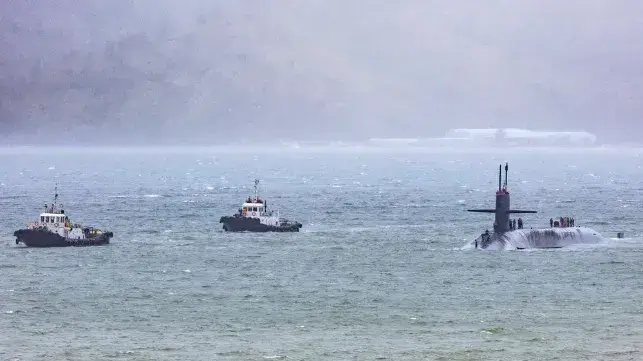Subic Bay Regains its Importance as a Forward Base

Subic Bay was once a key strategic facility for the U.S. Navy, and may soon be again: the service is ramping up plans for forward equipment storage and repair capacity in and around the area, preparing the sheltered anchorage for wartime use if the need ever arises.
After its liberation from the Japanese near the end of WWII, Subic Bay became a major U.S. military base. It grew throughout the Cold War, and it provided a major staging point during the war in Vietnam. At one point, it handled more fuel oil and more duty-free retail volume than any other naval facility in the world, a measurement of its importance for supporting personnel and vessel operations near the theater. But in 1991, after the U.S. and Philippine governments failed to agree on financial terms for a lease renewal, the base closed; with the Cold War and its military usefulness over, it became a commercial free zone under Philippine control, and the U.S. Navy withdrew to other bases in Guam, Okinawa and Yokosuka.
 Busy piers at Naval Station Subic Bay, 1981 (USN)
Busy piers at Naval Station Subic Bay, 1981 (USN)
With China's expansionist ambitions on the rise in the South China Sea and Taiwan Strait, Subic Bay is strategic once again. This defensible and well-equipped harbor is positioned within easy reach of contested waters: it lies about 300 nautical miles south of the Strait of Luzon and 300 nautical miles northeast of the Spratly Islands. For a destroyer at flank speed, that is less than a 10-hour commute to and from the battle zone for repairs, refueling, and vertical reloading of VLS missile cells - a task that requires sheltered-water surface conditions.
The Navy and Marine Corps both have an interest in Subic Bay for their basing needs. A new solicitation - first reported by USNI - requests proposals for a 270,000 square foot (six acre) warehouse and shop facility within the Subic Bay free zone. The giant building must be climate controlled, and will be used for "storage and maintenance of vehicles and vehicle equipment." The Marine Corps already has a 57,000 square foot storage warehouse in Subic Bay, and the RFP calls for real estate options close to this existing site.
The added storage and repair capacity would support a heightened American presence in the Philippines, including near-constant training rotations and joint exercises. As China ramps up its activities in nearby waters, Subic Bay also supports an increased U.S. Navy and Coast Guard presence. Just last week, the cruise missile sub USS Ohio (SSGN-726) made a rare appearance in Subic Bay to rendezvous with the USS Frank Cable, one of the service's two remaining sub tenders.
The SSGNs carry more than 150 Tomahawk missiles each, plus lockout chambers for use by special forces divers. They have been tested on covert and overt missions for decades: one of the four vessels in the class, USS Florida, played a role in the successful foreign intervention in Libya in 2011, which culminated in regime change. Given the SSGNs' deep magazine, stealth and general warfighting utility, the disclosure of their location is often viewed as geopolitical signaling, as seen before in the Mideast.
